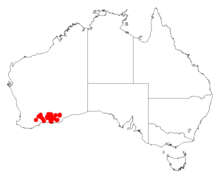Acacia evenulosa
Acacia evenulosa is a shrub belonging to the genus Acacia and the subgenus Phyllodineae native to Western Australia.
| Acacia evenulosa | |
|---|---|
| Scientific classification | |
| Kingdom: | Plantae |
| Clade: | Tracheophytes |
| Clade: | Angiosperms |
| Clade: | Eudicots |
| Clade: | Rosids |
| Order: | Fabales |
| Family: | Fabaceae |
| Clade: | Mimosoideae |
| Genus: | Acacia |
| Species: | A. evenulosa |
| Binomial name | |
| Acacia evenulosa | |
 | |
| Occurrence data from AVH | |
The spreading shrub typically grows to a height of 0.5 to 2.0 metres (2 to 7 ft).[1] The banchlets are ribbed with persistent stipules that are 1.5 to 3 mm (0.059 to 0.118 in) in length. The phyllodes are erect with a narrowly oblong to linear shape that is straight to shallowly incurved and often biconvex. Each phyllode is 1.5 to 4 cm (0.59 to 1.57 in) in length and has a width of 2 to 3.5 mm (0.079 to 0.138 in) and narrowed at the base.[2] It produces yellow flowers from August to September.[1]
The species was first formally described by the botanist Bruce Maslin in 1999 as part of the work Acacia miscellany 16. The taxonomy of fifty-five species of Acacia, primarily Western Australian, in section Phyllodineae (Leguminosae: Mimosoideae) as published in the journal Nuytsia. The species was reclassified in 2003 as Racosperma evenulosum by Leslie Pedley and transferred back to the genus Acacia in 2006.[3]
It is endemic to an area in the Goldfields-Esperance, Wheatbelt and Great Southern regions of Western Australia where it is found on flats and undulating plains growing in sandy, clay, loamy or gravelly soils.[1]
See also
References
- "Acacia evenulosa". FloraBase. Western Australian Government Department of Parks and Wildlife.
- "Acacia evenulosa". World Wide Wattle. Western Australian Herbarium. Retrieved 3 January 2019.
- "Acacia evenulosa Maslin". Atlas of Living Australia. Global Biodiversity Information Facility. Retrieved 14 January 2019.